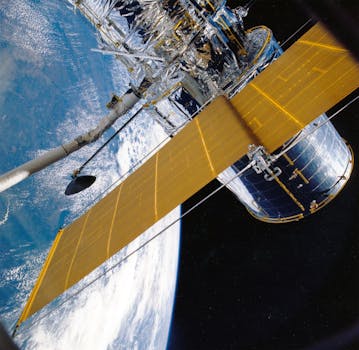From Geostationary to Low Earth Orbit: The Evolution of Satellite Telecommunications in 2023
The satellite telecommunications industry has undergone significant changes in recent years, with a shift from geostationary to low Earth orbit. This article explores the evolution of satellite telecommunications in 2023, including the benefits and challenges of low Earth orbit and the impact on the industry.

From Geostationary to Low Earth Orbit: The Evolution of Satellite Telecommunications in 2023
Focus Keyword: Satellite Telecommunications
Satellite telecommunications has come a long way since the launch of the first geostationary satellite in 1963. For decades, geostationary satellites have been the backbone of the satellite telecommunications industry, providing a wide range of services including television broadcasting, telecommunications, and navigation. However, in recent years, the industry has undergone a significant shift towards low Earth orbit (LEO) satellites. In this article, we will explore the evolution of satellite telecommunications in 2023, including the benefits and challenges of LEO satellites and the impact on the industry.
The geostationary orbit, which is approximately 36,000 kilometers above the equator, has been the traditional orbit for satellite telecommunications. Geostationary satellites have the advantage of being able to cover a large area of the Earth’s surface, making them ideal for services such as television broadcasting and telecommunications. However, they also have some significant drawbacks, including high latency and limited bandwidth. The high latency is due to the long distance between the satellite and the Earth’s surface, which can result in delays of up to 250 milliseconds. This can be a significant problem for applications that require real-time communication, such as video conferencing and online gaming.
In contrast, LEO satellites, which orbit the Earth at an altitude of around 160 to 2,000 kilometers, offer several advantages over geostationary satellites. They have lower latency, typically around 20-30 milliseconds, and higher bandwidth, making them ideal for applications that require real-time communication. LEO satellites also have the advantage of being able to provide coverage to remote and underserved areas, where traditional telecommunications infrastructure may not be available. One of the main challenges of LEO satellites is the need for a large constellation of satellites to provide global coverage. This can be a significant investment, requiring the launch of hundreds or even thousands of satellites.
The Benefits of Low Earth Orbit Satellites
LEO satellites have several benefits that make them an attractive option for satellite telecommunications. One of the main benefits is the lower latency, which makes them ideal for applications that require real-time communication. LEO satellites also have higher bandwidth, which enables them to support a wide range of services, including high-definition video streaming and online gaming. Another benefit of LEO satellites is their ability to provide coverage to remote and underserved areas, where traditional telecommunications infrastructure may not be available. This makes them an ideal solution for providing broadband internet access to rural and remote communities.
LEO satellites also have the advantage of being able to provide more secure and resilient communications. Because they are closer to the Earth’s surface, LEO satellites are less vulnerable to interference and jamming, making them a more secure option for military and government communications. They are also more resilient, as they can provide redundant coverage in the event of a satellite failure. This makes them an ideal solution for critical communications, such as emergency response and disaster recovery.
The Challenges of Low Earth Orbit Satellites
While LEO satellites offer several advantages, they also have some significant challenges. One of the main challenges is the need for a large constellation of satellites to provide global coverage. This can be a significant investment, requiring the launch of hundreds or even thousands of satellites. The cost of launching and maintaining a large constellation of satellites can be prohibitively expensive, making it a challenge for many companies to enter the market.
Another challenge of LEO satellites is the risk of interference and collisions. Because LEO satellites are closer to the Earth’s surface, they are more vulnerable to interference from other satellites and terrestrial systems. They are also at risk of collisions with other satellites and space debris, which can result in significant damage and even loss of the satellite. This makes it essential for companies to invest in advanced tracking and collision avoidance systems to minimize the risk of collisions.
Conclusion
In conclusion, the satellite telecommunications industry has undergone significant changes in recent years, with a shift from geostationary to low Earth orbit. LEO satellites offer several advantages, including lower latency, higher bandwidth, and the ability to provide coverage to remote and underserved areas. However, they also have some significant challenges, including the need for a large constellation of satellites and the risk of interference and collisions. Despite these challenges, LEO satellites are likely to play an increasingly important role in the satellite telecommunications industry, enabling a wide range of services and applications that require real-time communication.




